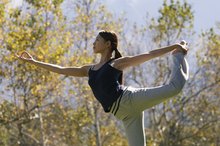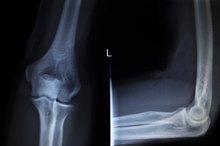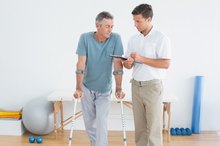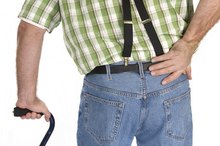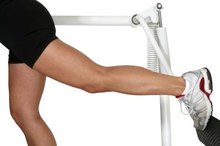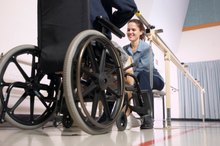Musculoskeletal Alignment in the Legs
The proper musculoskeletal alignment of the legs is extremely important for biomechanics. Muscle imbalances and poor joint functioning can lead to both acute and chronic injuries. Improper functioning of the leg mechanisms can lead to poor performance in athletics. Learning which joints need preventive or treatment conditioning to pull your legs into proper alignment is essential.
Proper Alignment of the Legs
The proper alignment of the legs is with your hips balanced over your knees over your ankles. Toes should be facing forward with your feet parallel. Looking at your body from the front, side and back will help you determine if everything is in place. If your joints are not stacked upon each other, you may have a combination of muscle imbalances and restrictions in the range of motion of your joints. Learning how to put them all in alignment again is vital.
- The proper alignment of the legs is with your hips balanced over your knees over your ankles.
Ankles
How Does Exercise Improve Your Posture?
Learn More
Improperly aligned ankles stem from a variety of things. Over pronation, when your ankles collapse in, and over supination when your ankles collapse out, are highly disruptive to proper walking and running mechanics. A lack of range of motion when you bring your toes to your shin or when you attempt to point your toes away from your shin can cause feet to turn in or out. Weak and inappropriately functioning ankles can lead to not only ankle injury but also injury of your knees and hips. Strengthening and stretching the muscles in your shins and calves can help put your ankle in proper alignment.
- Improperly aligned ankles stem from a variety of things.
- Over pronation, when your ankles collapse in, and over supination when your ankles collapse out, are highly disruptive to proper walking and running mechanics.
Knees
Knees are one of the most injured areas of the body. Most knee injuries are not due to contact situations but are due to weakness, improper alignment and poor landing skills. Keeping your toes visible beyond your knees whenever you complete a bending motion is extremely important. Knees require strong hamstrings, quadriceps and hip muscles to maintain alignment. Proper stretching and strengthening of these muscles reduces the risk of both acute and chronic knee injuries.
- Knees are one of the most injured areas of the body.
- Most knee injuries are not due to contact situations but are due to weakness, improper alignment and poor landing skills.
Hips
Torn Tendons & Ligaments From Hyperextension
Learn More
The hips are the final balancing act on the top of the legs. If your hips are not strong and in alignment with your ankles and knees, all the mechanics of your lower legs will be compromised. It is important to strengthen your buttocks, hips, lower back, stomach and legs to maintain this alignment. Preventing imbalances between one side and the other helps to promote good mechanics.
- The hips are the final balancing act on the top of the legs.
- If your hips are not strong and in alignment with your ankles and knees, all the mechanics of your lower legs will be compromised.
Exercises to Create Proper Alignment
Several exercises are important to perform on a regular basis to help to achieve and maintain proper alignment. Squats and lunges, while maintaining a visual contact on your toes beyond your knees is a great way to start. Stepping up to balance on a step or block will also create a method to strengthen joint alignment. All core-strengthening activities that can help to keep your lower back in proper position such as planks, cobras, back extensions, lateral legs lifts and crunches will help to keep your ankles in line with your knees in line with your toes.
- Several exercises are important to perform on a regular basis to help to achieve and maintain proper alignment.
- Stepping up to balance on a step or block will also create a method to strengthen joint alignment.
Related Articles
References
- The Body Worker: Principles of Posture and Structural Alignment
- National Academy of Sports Medicine: NSAM Essentials of Sports Performance Training: Michael Clark, 2010
- Asadi K, Mirbolook A, Heidarzadeh A, Mardani kivi M, Emami meybodi MK, Rouhi rad M. Association of soccer and genu varum in adolescents. Trauma Mon. 2015;20(2):e17184. doi:10.5812/traumamon.17184
- Aiyegbusi AI, Tella BA, Sanusi GA. Is genu varum a risk factor for the prevalence and severity of achilles tendinopathy? A cross-sectional study of Nigerian elite track and field athletes. Niger Postgrad Med J. 2020;27(2):87-92. doi:10.4103/npmj.npmj_179_19
- Samaei A, Bakhtiary AH, Elham F, Rezasoltani A. Effects of genu varum deformity on postural stability. Int J Sports Med. 2012;33(6):469-73. doi:10.1055/s-0031-1301331
- Heidari B. Knee osteoarthritis diagnosis, treatment and associated factors of progression: part II. Caspian J Intern Med. 2011;2(3):249-255.
- Park S, Ro H, Namkoong S. The effect of stretching and elastic band exercises on knee space distance and plantar pressure distribution during walking in young individuals with genu varum. J Korean Soc Phys Med. 2017;12(1):83-91. doi:10.13066/kspm.2017.12.1.83
- Boston Children's Hospital. Bowlegs diagnosis and treatment.
- American Academy of Orthopaedic Surgeons. Bowed legs. Updated February 2020.
- KidsHealth.org. Bow legs (genu varum). Updated February 2019.
Writer Bio
Tina Hatcher began writing articles for eHow and LIVESTRONG.com in 2010. Her fitness company specializes in weight loss, sports conditioning, and kids fitness. She holds a Bachelor of Science degree in exercise science and a Master of Science degree in cardiac rehabilitation and adult fitness, both from Virginia Tech.
